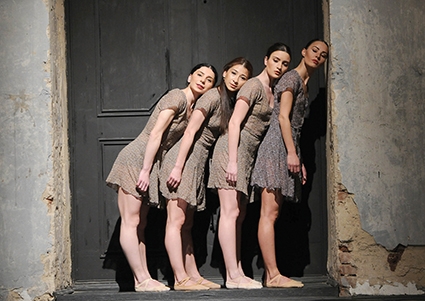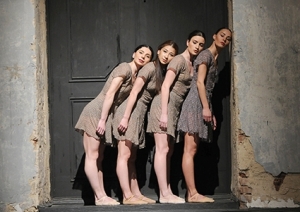“Culture is Not One of Life’s Luxuries. It is Life Itself”
Georgia, Armenia and Azerbaijan – all three countries have started to speak the language of contemporary art thanks to a project promoting culture. People serving a common cause and having shared interests have been unified by the Regional Art and Culture Project, implemented with the support of the Swiss Cooperation Office for the South Caucasus to last until February 2017.
“This is a place where people meet, exchange information, fall in love, embrace new ideas, and learn from each other,” Catherine Vasenina, a dance critic, wrote about the new Project. “Contemporary dance is very open and liberal; it combines many different genres and stands out from other forms of arts. The mixture of choreographic language presented at this Festival has been conditioned by various factors. The diverse and interesting traditional culture of Armenia, Azerbaijan and Georgia is an almost intact source of inspiration; authentic material that can be used originally, while it is still little known to the world of modern dance. The best way for the Caucasus to introduce and assert itself is to join the traditional culture of contemporary dance, which can be done through this Festival.”
Vasenina’s expectations were met: in 2015 the South Caucasus Contemporary Dance & Experimental Art Festival was held for the second time in Tbilisi. Two years ago the Festival was opened in a small hall at the Royal District Theatre. Considering the interest of the audience, in 2015, performances were conducted at the Rustaveli Theater involving a higher number of participants and guests. Shortly after the launch of the project, Swiss dancer and choreographer, Romain Guion, said that the organizers of the Festival were ambassadors of contemporary dance to the Caucasus, and the Festival itself served as the source of inspiration and a means for its numerous participants to discover themselves.
The idea of the project was born in 2012 as a response to the fact that in Georgia, and throughout the South Caucasus, experimental art and contemporary dances were undervalued compared to other traditional forms of art. Along with the Festival, the program of the project comprised different activities for the South Caucasus performers, including masterclasses in choreography and contemporary dances by foreign choreographers. Every year the region hosts tours of choreographic companies from foreign countries and local professionals are sent abroad to improve their skills.
Mariam Alexidze, Artistic Director of the Festival, choreographer: “It took us quite a while to break through classical basis and create something alternative and new. We invited participants with interesting ideas and performances from all three countries of the region. I remember the first meeting when the participants had almost no contact with each other. Gradually the dances eliminated the differences between them, and soon they became friends and started to speak the language of dance. We can see how they grow professionally and become better every day. We are very glad and proud of their success: they often get offers from abroad and continue to work independently. This is what we want to achieve: to assist their further development. Apart from dances, the Festival involves experimental art, which is also very interesting. For example, this year a Performance Festival was conducted.”
The Project was born in two organizations simultaneously – the Culture and Management Lab and the Swiss Cooperation Office in the South Caucasus. Very soon after the start of the project young artists appeared in Tbilisi equipped with two mobile folding platforms with plants, benches, a micro library and a projection screen. “The Garden on Wheels” stopped at different parts of the city for a few hours to turn them into a garden, create a green area and a platform for contemporary art. The young “bethonization” tendency in the city was supported by group Door on the Corner and other artists offering interesting events of visual and performance art. This was the first project of the Regional Art and Culture Project in South Caucasus. The creative beginning was followed by equally interesting events: depicting the forgotten culture, the everyday life and lifestyle of Dukhobors living in Javakheti in photos; the project “Discover your Pirosmani” offering exhibitions and expositions that made many viewers ponder art as a live process; Tskaltubo Art Festival, through which many creative people from different countries and cities established contacts with one another; the festival of contemporary arts “Ventilation” in Kutaisi; and the electronic music festival “Soundspring” in Batumi, involving lectures, masterclasses, workshops, etc.
“The Regional Art and Culture Project in the South Caucasus plays a significant role in generating new ideas; and a small grants program is a good start for implementing cultural projects,” one of the creators of the first Georgian video art archive, Alexi Soselia said. The online archive unites the moving pictures created by Georgian artists from 1990s to present. Two days after the presentation of the archive, the Pompidou Center got interested in the collection and, as a result, a number of exhibitions and presentations were held in Georgia and abroad including participation in Bonn Videonale. That online platform is where curators from different countries often find interesting videos and, consequently, invite Georgian artists to video exhibitions. In future the project curators aim to create a video art archive that covers the whole Caucasus.
Tamar Janashia, Executive Director, Culture and Management Lab: “Many people in Georgia still think that art is a picture exhibited in a museum, while modern art exceeded the limits and restrictions long ago. We are trying to make the program as diverse as possible. All projects we finance represent different fields. A lot of things are happening in different regions of Georgia, which we cannot see from the capital. So it is our goal to cover all the regions and help people contact one another. We are working in four directions: the first involves social projects for marginalized groups carried out by the Swiss non-governmental organization Artasfoundation. That organization facilitated implementation of many interesting projects in different parts of Georgia, including Abkhazia (43 events were held in 2015 alone). The second direction concerns the Festival of Contemporary Dance and Experimental Art; the third has to do with the Small Grants Program; and the fourth direction involves advanced trainings for South Caucasian culture managers. During the pilot phase we gained valuable experience which helped us to identify priorities for the future and to choose the right path. The main phase of the Project comprising 36 months started in September 2014 and involves Georgia, Azerbaijan and Armenia. We solved the problem with regional programs, namely the practice of implementing projects in all the countries according to the same principle. We worked individually with representatives of each country and set priorities after consulting with them. The new component, which was added to the main phase of the program and will start as of February 2016, is the professional development of cultural managers.”
Olivier Burki, Regional Director of the Swiss Cooperation Office for the South Caucasus: “The Caucasus is distinguished for its cultural diversity: monumental architecture, strong folklore, the art of jewelry, painting… and the tradition of hospitality. All these need further development and new forms, which requires the coexistence of experimental and traditional art. Our interest in contemporary art is conditioned by the following factors: it gets less attention than traditional culture; it is undergoing the process of development, and is facing challenges and problems. Today, the people working in that field have little chance of survival and development. We want to promote and encourage the professional growth of talented young people. The project is aimed at supporting innovations in the South Caucasian countries and creating diverse culture and art through a dialogue in the regions as well as in cities. Considering the multi-ethnic character of the region, art and culture is one important contribution to harmonious interaction among people. This Project is also important because of the social component implying involvement of socially vulnerable groups of population with little possibilities of development. According to the policy of the Swiss Agency for Development and Cooperation (SDC), culture is not one of life’s luxuries, it is life itself. Culture is very important and valuable for us, we are glad and proud to foster its expansion.”
The Swiss Cooperation Office for the South Caucasus is the main organization implementing humanitarian and other development projects funded by different agencies of the Swiss Government. The organization started its activities in the region in 1988 (the first project was rendering aid to the victims of the earthquake in Spitak, Armenia) and has since achieved considerable success in such priority fields as providing internally displaced persons with accommodation, reducing the risk of natural disasters, economic development in rural areas, supporting infrastructure projects and economic policy. Olivier Burki thinks that the Contemporary Art and Culture Project will also contribute to economic growth in the region. The efforts taken in that direction have already produced good results.
Olivier Burki: “The role and function of the Swiss Cooperation Office is to contribute to poverty reduction and providing better living conditions for people. Culture and economics are closely connected with each other and culture can be used for economic development and growth. There is a big potential for that, for example, tourism and the projects carried out within the frameworks of our program, which help to attract tourists. Many people come to attend and participate in festivals. The projects must now become sustainable to be able to function independently.”











